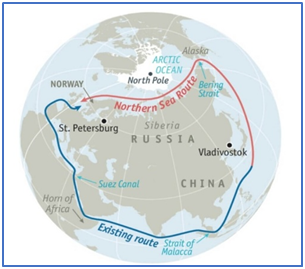Why in news?
- Murmansk, popularly called the capital of the Arctic region and the beginning point of the Northern Sea Route (NSR), is witnessing the rising trend of Indian involvement in cargo traffic.
- India has been showing greater interest regarding the NSR for a variety of reasons.
What’s in today’s article?
News Summary: India and the Northern Sea Route
Why is the Arctic region significant to India?
- The Arctic region is above the Arctic Circle and includes the Arctic Ocean with the North Pole at its centre.
- The vulnerability of this region to unprecedented changes in the climate may have an impact on India in terms of economic security, water security and sustainability.
- The region also constitutes the largest unexplored prospective area for hydrocarbons remaining on the earth.
- As per experts, the region may hold over 40 percent of the current global reserves of oil and gas. There may also be significant reserves of coal, zinc and silver.
India’s engagement with the Arctic
- India’s engagement with the Arctic can be traced to the signing of the Svalbard Treaty in February 1920 in Paris.
- India is undertaking several scientific studies and research in the Arctic region. This encompasses atmospheric, biological, marine, hydrological and glaciological studies.
- Apart from setting up a research station, Himadri, at Svalbard, in 2008, the country launched its inaugural multi-sensor moored observatory and northernmost atmospheric laboratory in 2014 and 2016 respectively.
- Till last year, thirteen expeditions to the Arctic were successfully conducted.
- In May 2013, India became an observer-state of the Arctic Council along with five others including China.
Northern Sea Route (NSR)
- The Northern Sea Route (NSR), the shortest shipping route for freight transportation between Europe and countries of the Asia-Pacific region, straddles four seas of the Arctic Ocean.
- Running to 5,600 km, the Route begins at the boundary between the Barents and the Kara seas (Kara Strait) and ends in the Bering Strait (Provideniya Bay).
- As per one research paper, distance savings along the NSR can be as high as 50% compared to the currently used shipping lanes via Suez or Panama.
- The 2021 blockage of the Suez Canal, which forms part of the widely-used maritime route involving Europe and Asia, has led to greater attention on the NSR.

How is Russia making the NSR navigable?
- As the seas of the Arctic Ocean remain icebound during most of the year, the icebreaking assistance is organised to ensure safe navigation along the NSR.
- Russia is the only country in the world with a nuclear-powered icebreaker fleet.
Driving factors for India to participate in the NSR development
- With India increasingly importing crude oil and coal from Russia in recent years, NSR provides a reliable and safe transport route.
- The NSR, as a transit route, assumes importance, given India’s geographical position and the major share of its trade associated with sea transportation.
- The Chennai-Vladivostok Maritime Corridor (CVMC) project is being examined as one linking with another organise international container transit through the NSR.
- The 10,500 km-long CVMC, passing through the Sea of Japan, the South China Sea and Malacca Strait, will bring down transport time to 12 days.
- This is almost a third of what is taken under the existing St. Petersburg-Mumbai route of 16,000 km.
- Experts are discussing the possibility of China and Russia gaining collective influence over the NSR.










